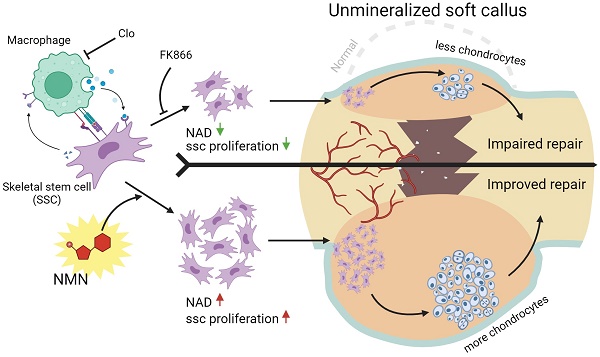
New Findings Illustrate Unanticipated Resilience of Skeletal Muscle to NAD Deficiency
A pioneering investigation conducted by the Novo Nordisk Foundation Center for Basic Metabolic Research has disrupted enduring beliefs in molecular biology and aging studies, uncovering that skeletal muscle might not rely on nicotinamide adenine dinucleotide (NAD) as much as once thought. Featured in Cell Metabolism, the research illustrates for the first time that mouse muscle tissue retains its structural and functional integrity—even after experiencing a loss of over 85% of its total NAD.
NAD: A Fundamental Cellular Element (With Considerations)
For many years, researchers have highlighted the essential function of NAD in energy metabolism, as it enables the conversion of nutrients into energy utilized by cells. Additionally, NAD affects DNA repair, stress reaction, and the management of cellular aging and metabolism. The age-related reduction in NAD has been linked to mitochondrial dysfunction, muscle weakness, and degenerative diseases, fostering the popularity of NAD-enhancing supplements promoted as anti-aging treatments.
However, the recent study presents persuasive evidence that mature skeletal muscle may exhibit greater resilience to diminished NAD levels than previously assumed.
Experimental Development: Silencing NAD Production in Muscle
To examine the necessity of NAD in skeletal muscle, the investigators genetically modified mice to induce the deletion of the NAMPT gene solely in their skeletal muscle cells. NAMPT is crucial for NAD biosynthesis, recycling nicotinamide into NAD. Following silencing of the gene, NAD levels in the muscle plummeted by an astonishing 85%—a decrease vastly more severe than the usual 10–30% decline observed in older individuals.
In spite of the significant reduction, the mice exhibited no notable decrease in muscle mass, strength, or coordination. Morphological assessments verified that muscle fiber integrity remained unaltered. Performance tests in exercise, such as voluntary wheel running and forced treadmill endurance assessments, indicated no dip in stamina or muscular efficiency—critical signs that their skeletal muscles were functioning normally despite stress.
Aging Unaffected by Prolonged NAD Depletion
Perhaps the most remarkable discovery stemmed from the team’s extended observation period. Even with muscle-specific NAD depletion sustained for nearly two years—essentially throughout the mouse’s entire natural lifespan—no indicators of premature muscle aging or systemic metabolic downturn were observed. DNA methylation clocks, commonly employed to assess biological aging, indicated that the muscles aged at a standard pace despite the ongoing NAD deficiency.
“These results contradict the assumption that NAD deficiency triggers aging-related muscle dysfunction and prompt a reassessment of NAD’s significance in energy metabolism,” articulated the study authors.
Mitochondria and Metabolism Remain Stable
Mitochondria, the energy-generating organelles that significantly depend on NAD for oxidative phosphorylation, were another key aspect of the study. Surprisingly, mitochondrial functionality stayed robust even with a 50% decrease in mitochondrial NAD quantities. Sophisticated computational modeling reinforced this finding, suggesting that mitochondrial dysfunction becomes critical only when NAD drops by more than 99%.
Additional subtle metabolic shifts were observed, including a slight rise in muscle glycogen levels and modified dynamics of reactive oxygen species (ROS) in the impacted muscles. Nonetheless, these changes did not considerably hinder muscular or metabolic well-being.
Implications for Aging Research and Supplementation Practices
This research introduces fresh inquiries regarding the previously accepted viewpoint that decreasing NAD levels are a primary factor in muscle deterioration with age. While earlier investigations—particularly those focusing on embryos or systemic NAD deficiency—have demonstrated serious consequences from NAMPT loss, the current results indicate that the timing of intervention and tissue specificity are vital in assessing impacts.
The results also provide new perspectives on the common use of NAD-enhancing supplements. While certain tissues or pathological conditions might benefit from elevated NAD levels, mature skeletal muscle seems to uphold its functional integrity at lower NAD concentrations. This suggests that applying a blanket assumption about NAD’s benefits across all tissues could be an oversimplification.
Rethinking the Function of NAD
The outcomes redefine our comprehension of metabolic resilience and aging. They highlight the intricacies of age-related decline and caution against the presumption of straightforward correlations between molecular indicators like NAD and health results. Rather than uniformly driving age-associated muscle degeneration, NAD may exert a more nuanced, context-specific influence—with its deficiency potentially less detrimental in adult muscle compared to developmental stages or specific disease scenarios.
The authors advocate for additional research into how various tissues react to NAD depletion and how genetic, environmental, or developmental elements influence NAD’s role in health and disease.
Conclusion: A Refined Perspective on a Crucial Molecule
While this research does not diminish the importance of NAD or the possible advantages of sustaining optimal levels in some situations, it questions the assumption that reduced NAD necessarily correlates with poor muscle health. The findings pave the way for more targeted inquiries into NAD metabolism and the creation of precision treatments that consider when, where, and how NAD genuinely matters.
As we explore the complexities of cellular biology, insights such as these remind the scientific community—and society at large—that longevity and health are not dictated by any single molecule but by